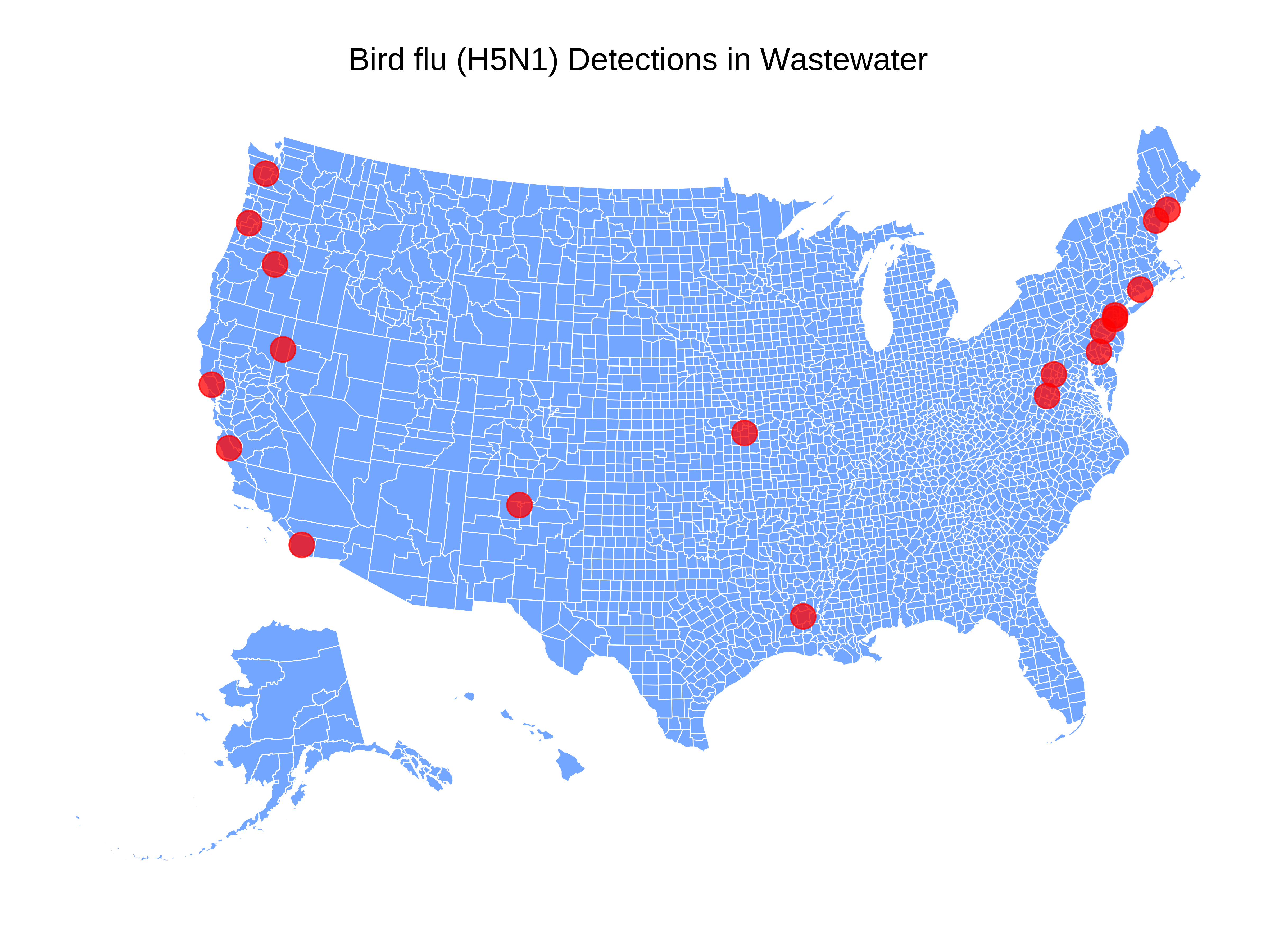At Biobot, we analyze wastewater across the country for various infectious disease pathogens....

Respiratory Virus Risk Reports
Comprehensive Insights for COVID-19, Influenza, and RSV
COVID-19, Influenza, and RSV Wastewater Monitoring in the U.S. | Week of March 11, 2024
This respiratory season, we are analyzing wastewater for the presence of respiratory syncytial virus (RSV) and influenza virus (types A and B). Together with COVID-19, these three pathogens are outsized contributors to our seasonal respiratory illness burden. In this data series, we’ll guide you through the wealth of data we’ve gathered from our Biobot Network of national sampling sites, aiming to shed light on emerging trends in respiratory virus activity and community viral load. Our goal is to equip you with information to make informed decisions, especially as we approach the holiday season and gather with family and friends.
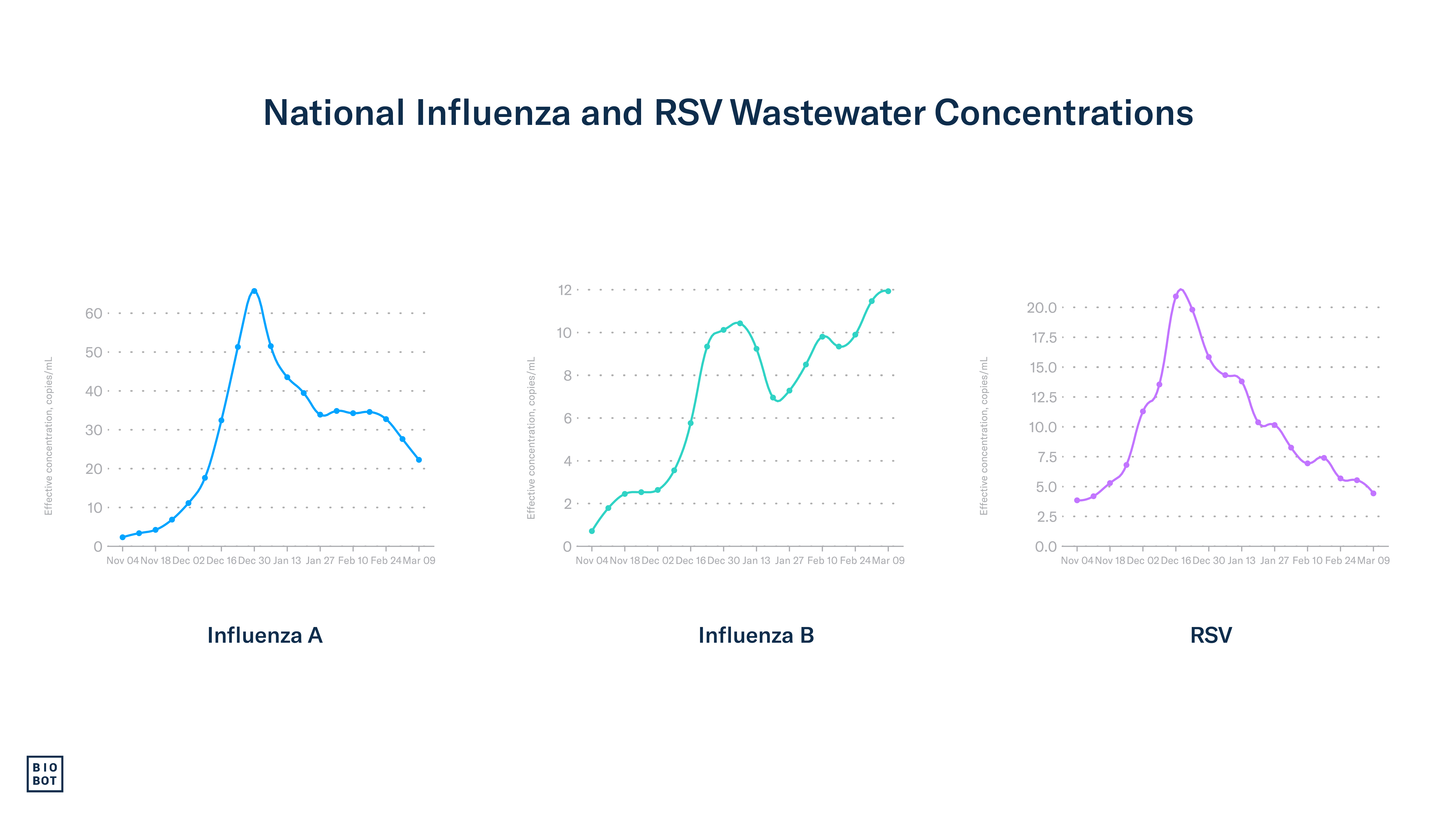

Data Note: Samples are collected from participating locations and processed by our lab team on a rolling basis. Each point on the figure represents the weekly average concentration from Sunday – Saturday (corresponding to the MMWR week), aligned to that week’s Saturday.
Contributors

Marisa Donnelly, PhD
Public Health Partnerships Epidemiologist

Max Imakaev, PhD
Data Scientist
Previous Risk Reports
Summary: Week of 3/11/24
In great news this week, data from Biobot’s national wastewater network and clinical disease monitoring show that SARS-CoV-2, RSV, and influenza A activity are all declining. National average wastewater concentrations for SARS-CoV-2, RSV, and influenza A all declined during week 10. While clinical metrics for COVID-19 and RSV showed signals of declining illness burden, influenza clinical metrics remained elevated, indicating that the flu-associated disease burden remains high. Despite some elevated metrics, it still appears that we are heading towards reduced activity for all three major respiratory illnesses.
The Bottom Line: As we get closer to the end of the respiratory virus season, viral transmission and circulation is still ongoing, especially for influenza. It is still an important time to reduce contact with others if you are feeling ill, consider wearing a mask in crowded environments, and keep up to date with vaccines and boosters. Taking these measures can help keep you and your loved ones healthy.
National Outlook
RSV
In good news, national RSV wastewater concentrations declined during week 10 (through March 9th), and are now at levels similar to what we observed in early-November. These low levels suggest that we are nearing the end of the RSV season.
Clinical RSV metrics have also continued to decline through week 9 (through March 2nd). The percentage of PCR tests that are positive (test positivity) for RSV continued to decrease, going down from 3.8% the previous week to 3.2% in week 9. Hospitalization rates also continue to decline nationally and for all age groups.
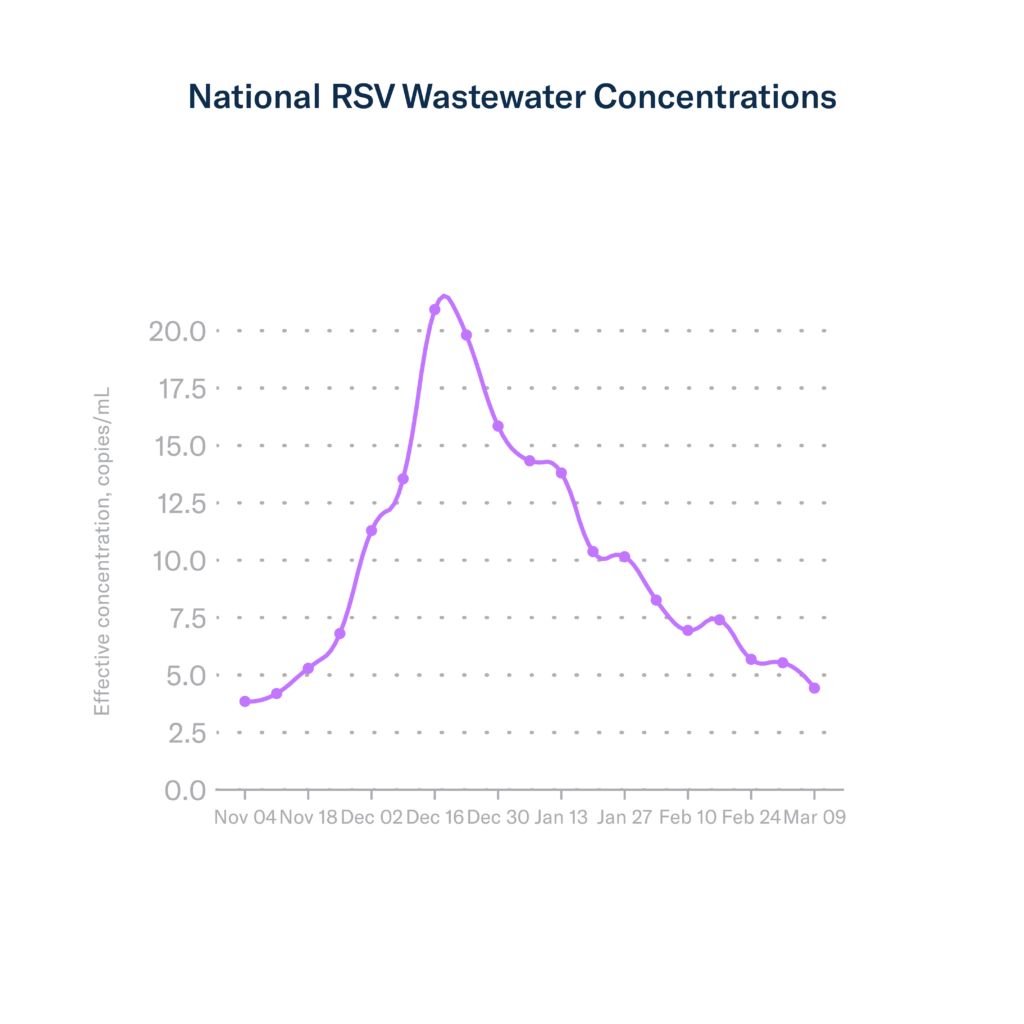
Influenza
In great news, influenza A wastewater concentrations significantly decreased in week 10, going down 19.7% compared to the previous week. This is important as influenza A has driven most clinical burden in the US this season and we anticipate that these observed decreases will lead to further reduction in clinical burden. Influenza B concentrations, however, increased by about 3.5% during week 10, and remain high.
In week 9 (one week behind wastwater data), two out of three of the major clinical influenza metrics did not change, indicating that the disease burden due to influenza remains elevated. Test positivity from clinical labs remained stable from week 8 to week 9, going from 14.2% to 13.9% currently. For the third week in a row, the number of hospitalizations also remained stable, with 10,060 hospitalizations due to flu during week 9. In good news, the percentage of outpatient visits for flu-like symptoms – typical in flu, RSV, and COVID-19 patients – decreased slightly, going from 4.4% in week 8 to 4.1% in week 9. Despite elevated clinical metrics, wastewater data indicates that trends in influenza A activity have shifted towards declining activity, and we anticipate that as clinical data updates, similar trends will be observed.
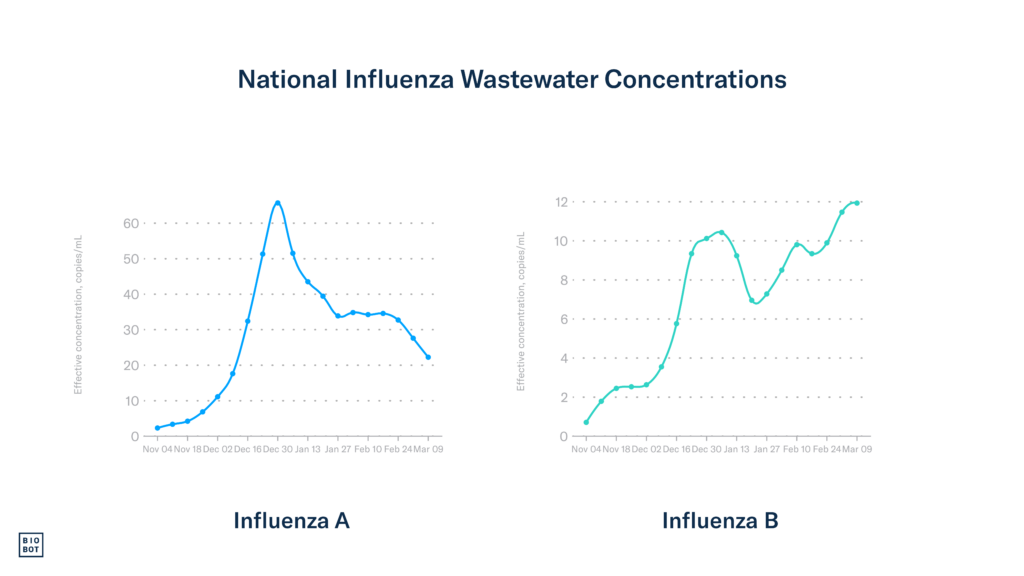
COVID-19
Wastewater data show that COVID-19 activity and community viral load decreased again in the previous week. As of week 10, the national SARS-CoV-2 wastewater concentration average is 541 copies/mL.
In good news, most of the major national clinical COVID-19 metrics are continuing to trend downward during week 9. COVID-19 hospitalizations dropped from around 17,300 in week 8 to around 15,100 in week 9. The national COVID-19 test positivity rate slightly declined from 7.1% in week 8 to 6.5% in week 9. Deaths due to COVID-19 did not change in the previous week and currently represent 2.2% of deaths in the US. The sustained downward trends we are observing in wastewater concentrations and clinical metrics are all great signs that we are progressing out of this COVID-19 surge.
Regional
The South
RSV: In the South, RSV wastewater concentrations were consistent and remained low in week 10. Concentrations are now lower than they were when we began testing in late October. During week 9, RSV test positivity levels remained stable, currently at 2.2%.This value is similar to what we saw at the beginning of the RSV season in early September, signaling that RSV activity in the South is low.
Influenza: The South experienced a small uptick in influenza A wastewater concentrations during week 10, while influenza B concentrations had a larger increase. These increases in influenza A wastewater concentrations follow similar trends we’ve been observing in the Midwest and Northeast in recent weeks. While most states in the South experienced a decrease in outpatient visits for influenza-like illness (ILI) during week 9, 7 states and the District of Columbia remain in the High or Very High ILI levels. The persistence of clinical data at high levels is in line with elevated wastewater concentrations. We hope that influenza activity in the South begins declining again soon.
COVID-19: SARS-CoV-2 wastewater concentrations slightly declined in the South during week 10, currently at 490 copies/mL. The number of states reporting increases in hospitalizations remained constant in the South during week 9, with 3 states reporting small increases (Oklahoma, Tennessee, and West Virginia). All other Southern states experienced decreases or no change in hospitalizations. These trends suggest that the South is heading in the right direction with declining COVID-19 activity, even with elevated activity persisting in some states.
The Midwest
RSV: RSV wastewater concentrations significantly declined in the Midwest during week 10, reaching levels as low as what we observed in early December. Test positivity during week 9 continued to decline, dropping down to 3.9%. While RSV activity has lingered in the Midwest a bit longer than other regions, these declining trends are good signs that the Midwest is getting closer to the end of the season.
Influenza: In great news, influenza A wastewater concentrations significantly declined in week 10 following a wave in increasing concentrations. Influenza B concentrations also declined in week 10 for the first time since December. Clinical data shows that about half of Midwest states experienced a decrease in influenza-like illness outpatient visits, but that 7 states remain in the High or Very High ILI activity level. We anticipate that as clinical data updates we’ll have more good news about decreasing influenza burden in the Midwest.
COVID-19: In good news, SARS-CoV-2 wastewater concentrations began declining again in the Midwest during week 10, currently at 609 copies/mL. In a great turn of events compared to last week’s report, almost all states in the Midwest experienced a decline in COVID-19-associated hospitalizations during week 9. Michigan is the only state that experienced a small increase in hospitalizations.
The Northeast
RSV: RSV wastewater concentrations in the Northeast significantly declined during week 10, reaching levels as low as what we observed in early November. RSV test positivity continued to decline during week 9, currently at 1.6%. RSV activity remains quite low in the Northwest.
Influenza: Continuing the good news from last week, the Northeast experienced another big drop in influenza A wastewater concentrations in week 10. Influenza B concentrations, however, remained elevated. Clinical metrics were mostly stable during week 9 in the Northeast, with only two states showing small increases in influenza-like illness outpatient visits (New Hampshire and Vermont). Unfortunately, New Hampshire, Massachusetts, New Jersey, and New York City remain in the High ILI activity level. The Northeast continues to head in the right direction towards reduced influenza activity.
COVID-19: SARS-CoV-2 wastewater concentrations slightly declined in the Northeast during week 10, currently at 691 copies/mL. Similar to last week, the Northwest continues to show some good signs of continued decline in COVID-19 disease burden during week 9, with all but two states (Maryland and Delaware) experiencing a decrease in COVID-19-associated hospitalizations.
The West
RSV: RSV wastewater concentrations were consistent and low in West during week 10, currently at levels observed in early December. Unfortunately, RSV test positivity increased in the West during week 9, currently at 3.7%. We’ll keep an eye on the West in hopes that RSV activity remains low.
Influenza: Wastewater concentrations for influenza A remained stable and low in the West during week 10, and are now at similar levels to those observed in late November. Influenza B concentrations increased slightly during week 10. As anticipated, following continued declines in influenza A wastewater concentrations, clinical metrics in the West during week 8 showed good signs of improvement. All but two states in the West (Alaska and New Mexico) experienced decreases in influenza-like illness outpatient visits. New Mexico is currently the only state in the High or Very High ILI activity level.
COVID-19: SARS-CoV-2 wastewater concentrations continued to decline in the West during week 10, currently at 300 copies/mL. These are the lowest concentrations observed in the West since July of 2023. While most states in the West experienced a decrease in COVID-19 hospitalizations, four states experienced increases (Hawaii, Washington, Montana, and Nevada). It appears that elevated COVID-19 activity is persisting in some Western states, and we hope that these trends reverse soon.
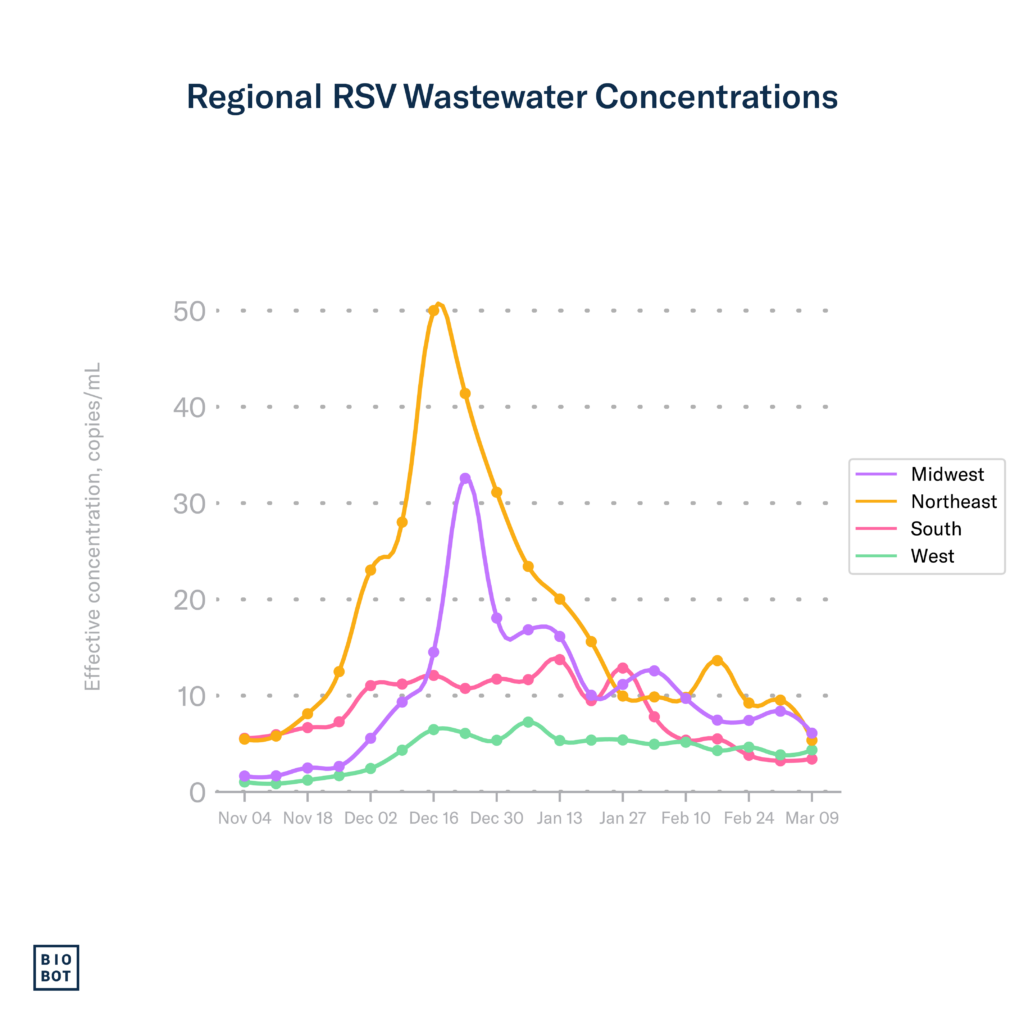
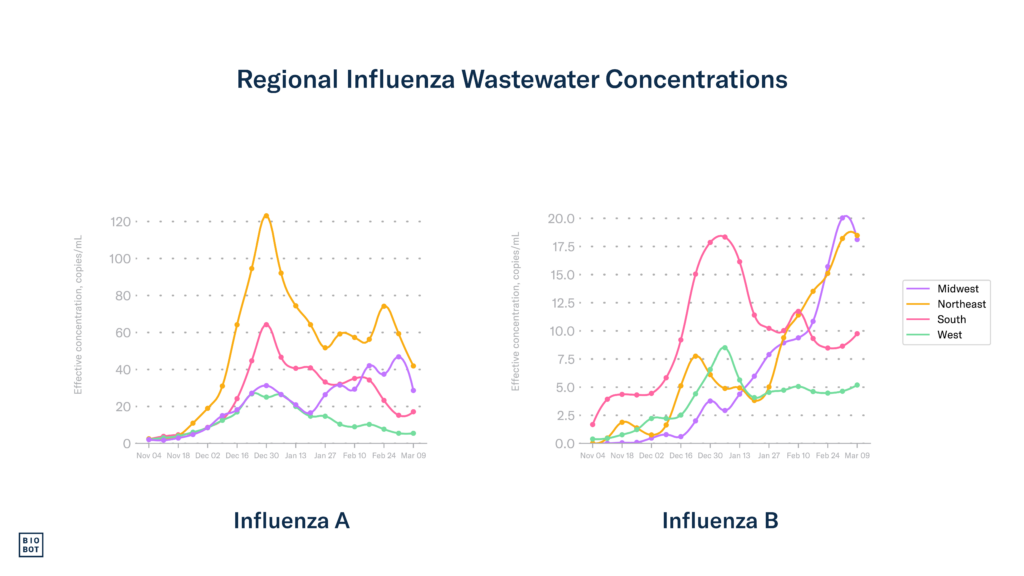
Footnotes:
Wastewater data from Biobot Analytics for RSV, influenza, and SARS-CoV-2 are through March 9, 2024 (MMWR week 10). Clinical data on testing, hospitalizations, and emergency department visits for RSV, influenza, and COVID-19 are from the Centers for Disease Control and Prevention. Updates to clinical data for RSV, influenza, and COVID-19 are through March 2, 2024 (MMWR week 9).




